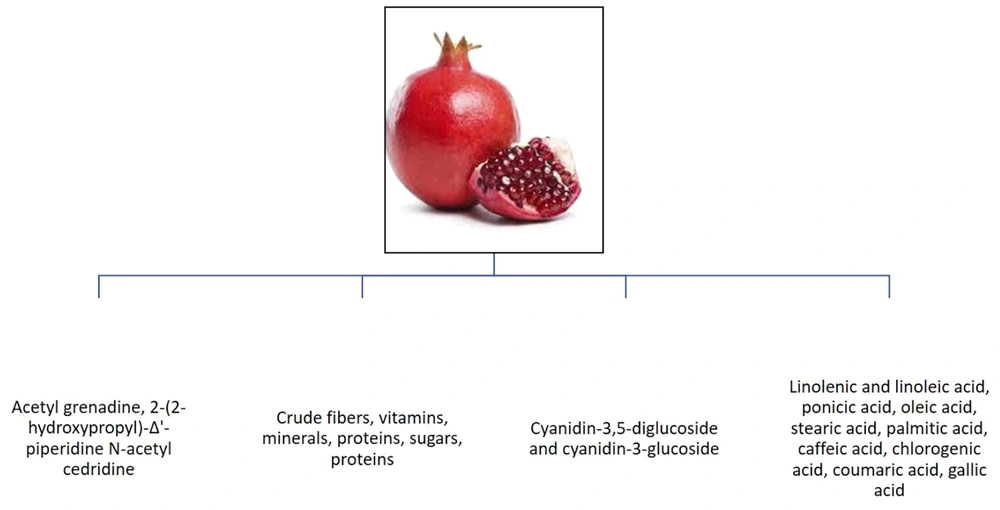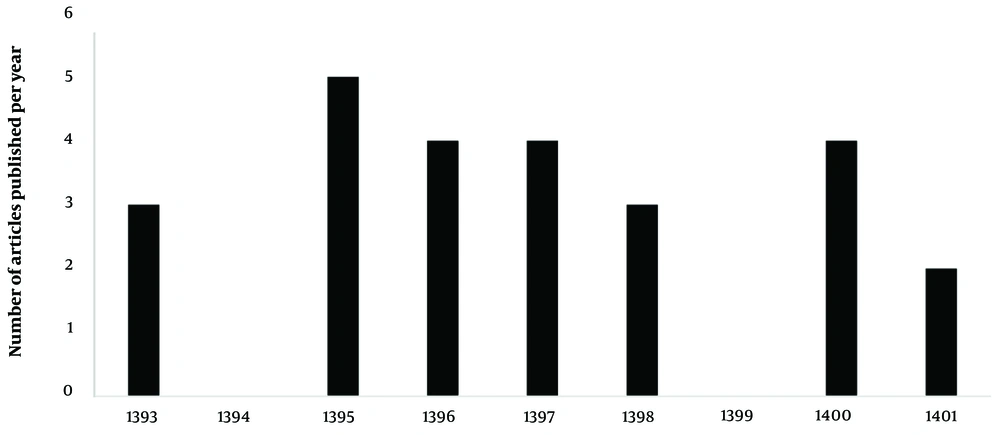1. Context
Pomegranate, with the scientific name Punica granatum L., is a long-lived and drought-resistant plant. Arid and semi-arid areas are very suitable for growing pomegranate trees. They are widely cultivated in Iran, India, and Mediterranean countries such as Turkey, Egypt, Tunisia, Spain, and Morocco (1). Pomegranate is obtained from a small leafy tree belonging to the Lythraceae family. The cultivation and consumption of pomegranate dates back to at least 3000 years BC. The pomegranate fruit is a flesh berry with an almost round shape, crowned by a calyx. This herb has a relatively thick skin with an outer colored layer, and the internal structure of its fruit consists of multi-branched chambers separated by membrane walls. Considering the health-promoting properties of pomegranate, either its fresh fruits, fruit juice, jam, or food supplements, the use of this herb has increased significantly in the last decade (2). Pomegranate is a rich source of valuable nutrients and contains hydrolyzable tannins, condensed tannins, flavonols, anthocyanins, and phenolic and organic acids. The exact composition of the fruit depends on many factors, such as the species, soil condition, climate, ripening stage, cultivation techniques, processing conditions, and storage conditions (3). The main components of pomegranate fruit include its juice, seeds, and peel, each of which contains a variety of phytochemicals, macronutrients, and micronutrients.
Arils contain the edible parts of the fruit. Exocarp, i.e., pomegranate skin, constitutes about 50% of the whole fruit, while its edible part consists of 10% of the seeds and 40% of the arils (4). The seeds contain proteins, crude fibers, vitamins, minerals, pectin, sugars, polyphenols, and isoflavones. Pomegranate seed oil (12 to 20% of the whole ingredient) contains high amounts of polyunsaturated fatty acids such as linolenic and linoleic acids. Also, other lipids such as punicic acid, oleic acid, stearic acid, and palmitic acid are found in the seed (5). Pomegranate juice is a good source of fructose, sucrose, and glucose. Phenolic acids, mainly gallic acid and ellagic acid, which belong to hydroxybenzoic acids, as well as caffeic acid, chlorogenic acid, and p-coumaric acid, which belong to hydroxycinnamic acids, are among the main compounds found in pomegranate juice (5). Pomegranate skin also contains alkaloid compounds such as acetyl grenadine, 2-(2-hydroxypropyl)-Δ'-piperidine, cedridine, and N-acetyl cedridine. Anthocyanins constitute another group of compounds that play an important role in promoting the biological properties of pomegranate as a functional food. These water-soluble pigments belong to the flavonoid family and are responsible for the color of the fruit and juice of pomegranate. The main anthocyanins in pomegranate are cyanidin-3,5-diglucoside and cyanidin-3-glucoside (3).
Pomegranate skin accounts for about 40 - 50% of the fruit’s weight and is an excellent source of phenolic compounds (flavonoids, phenolic acids, and tannins) and flavonoids (flavonols, anthocyanins, ellagitannins, and phenolic acids). Evidence shows that the peel of pomegranate has a higher concentration of phenolic compounds compared to its juice (Figure 1) (6).
Due to the presence of a wide range of phytochemical compounds in different parts of pomegranate, this fruit is believed to possess many beneficial effects on health, including antioxidant, anti-inflammatory, anti-cancer, antibacterial, cardioprotective, and many other effects (7).
Evidence shows that pomegranate has a protective effect on the integrity of blood vessels due to the presence of hydrolyzable tannins, ellagitannins, and ellagic acid, as well as other compounds such as anthocyanins and flavonoids. On the other hand, by reducing oxidative stress, platelet aggregation, and absorption of fat by macrophages, pomegranate promotes a positive role in regulating the function of vascular endothelial cells and blood pressure (8). It has been reported that pomegranate stimulates pancreatic beta cells and insulin secretion due to its antioxidant and polyphenolic compounds, contributing to blood sugar control (9). On the other hand, the compounds available in pomegranate reduce the progression of neurodegenerative diseases such as Parkinson’s and Alzheimer’s (10). Studies have also reported that pomegranate can have beneficial effects on other diseases, such as osteoarthritis (11), as well as on the indicators of metabolic syndrome, including weight loss, blood pressure, fasting blood glucose, triglycerides, total cholesterol, and low-density lipoprotein cholesterol (12).
Considering the therapeutic effects of pomegranate, which closely mimic those of physical activities, exercise physiology researchers have investigated the combinational effects of various training programs along with consuming various forms of pomegranate (i.e., extract, juice, seeds, and skin). Based on this, the present study aimed to review the studies conducted by Iranian researchers investigating the combinational effects of pomegranate and physical activities on health.
2. Methodology
This research employed a scientometric approach to collect data from the SID database and Google Scholar in the latter half of December 2021. The statistical population of this study comprised scientific publications by Iranian researchers in the fields of sports sciences, sports physiology, and health, indexed in the SID database from April 1, 2001, to December 2022. Clinical trials and field studies conducted on various populations, including athletes, healthy individuals, and those with health conditions (either men or women), as well as animal studies were included. Physical activity was defined as either an activity session or a training session encompassing aerobic, resistance, or strength exercises. In order to conduct a comprehensive search for pomegranate-related studies, keywords such as extract, pomegranate juice, seed, and peel were utilized. In order to ensure objectivity and enhance search accuracy, two experts in sports physiology independently conducted the literature search using the predetermined search strategy.
3. Results
From April 1, 2001, to December 2022, Iranian exercise physiology researchers published 25 articles in Persian language journals, using two types of exercise interventions along with consuming various pomegranate compounds. Out of these 25 articles, 19 studies used pomegranate juice; one study used pomegranate oil; two studies used pomegranate tablets, and 3 studies used pomegranate peel extract.
Four of these studies had been conducted on animal subjects, and the rest were on human subjects. Most of the studies were conducted on obese and diabetic women (n = 9 out of 25), followed by female survivors of breast cancer. Aerobic exercise was the most common type of exercise program (n = 15 out of 25), followed by restorative activity (n = 5), resistance exercise (n = 4), and combined exercise (n = 1). The most studied outcomes were related to metabolic factors, followed by oxidative stress markers. Figure 2 depicts the number of articles published per year.
Different parts of pomegranate fruit contain antioxidant, anti-inflammatory, sugar-lowering, and lipid-reducing compounds, etc. The presence of these compounds has encouraged sports physiologists to favor the use of pomegranate along with physical exercises as an effective non-pharmaceutical strategy to strengthen the health-promoting effects of training programs. As mentioned, most of the studies conducted in this field have investigated metabolic markers as outcomes. In this section, the results of some of these studies have been discussed.
Rahimifardin et al. investigated the effects of eight weeks of pomegranate supplementation and aerobic exercise on total antioxidant capacity and lipid peroxidation in overweight men. The results showed that the simultaneous use of pomegranate supplement and aerobic exercise decreased malondialdehyde levels as a lipid peroxidation marker, but no significant effect was observed on total antioxidant capacity (13). Akbarpour et al. showed that resistance training with consumption of pomegranate juice effectively improves insulin secretion and glycemic control. This improvement can be attributed to increases in Glucagon-like peptide-1 and dipeptidyl peptidase 4 levels (14).
In another study, Barari et al. investigated the effects of six weeks of consuming pomegranate juice and doing aerobic exercise on paraoxonase-1 levels and plasma lipid profile in middle-aged women with type 2 diabetes. The results showed that the simultaneous consumption of pomegranate juice and performing aerobic exercise significantly increased paraoxonase-1 and HDL levels and considerably decreased TG, TC, and LDL levels, indicating the protective effects of pomegranate juice and aerobic exercise on cardiovascular mediators by improving the lipid profile and preventing the oxidation of lipoproteins (15).
These researchers concluded that eight weeks of combined training (aerobic resistance) along with the consumption of pomegranate concentrates could affect the levels of glucose and insulin, as well as insulin resistance, indicating beneficial effects on the indicators of metabolic syndrome and cardiorespiratory endurance (14).
Farhadi et al. reported a decrease in CRP in healthy men consuming pomegranate tablets simultaneously with performing aerobic exercise, reflecting the anti-inflammatory effects of these two interventions (16). In line with these results, Yarmohammadi and Mahjoub reported a decrease in malondialdehyde in postmenopausal women with type 2 diabetes who started to take pomegranate extract and concomitantly perform aerobic exercise, while the consumption of pomegranate extracts alone did not have a significant effect on the level of malondialdehyde (17).
Bonyadi and Abedi reported a decrease in lipid peroxidation and vascular inflammation indices in obese women simultaneously performing aerobic exercise and consuming pomegranate supplements, confirming the antioxidant and anti-inflammatory effects of the combinational intervention (18). The effects of aerobic exercise and pomegranate fruit supplementation on the concentration of adipokines in women with type 2 diabetes were studied by Abdi and Mohajer Iravani. Six weeks of aerobic training combined with consuming pomegranate fruit extract increased adiponectin and decreased insulin resistance in diabetic women. These findings suggested that aerobic exercise and pomegranate fruit extract exerted their antioxidant and anti-inflammatory effects by increasing adiponectin and decreasing insulin resistance in women with type 2 diabetes (19). The antioxidant effects of aerobic exercise and pomegranate juice were explored by Rouzbehan et al. in women who survived breast cancer. In a recent study, 8 weeks and 3 sessions of aerobic exercise, along with drinking 100 mL of pomegranate juice, decreased oxidative markers and increased antioxidant mediators in women who survived breast cancer. On the other hand, exercise alone had a significant effect on all oxidative markers except for malonaldehyde. These findings emphasized the synergistic effects of aerobic exercise and pomegranate juice supplementation on oxidative stress markers (20).
In a study by Akbarpour et al., the effects of resistance training along with pomegranate juice supplementation were investigated on oxidative stress markers and lipid profiles in women with type 2 diabetes, and the results showed that eight weeks of resistance training combined with drinking 100 mL of pomegranate juice significantly increased SOD, GPX, and HDL levels and significantly decreased MDA and LDL levels (14). Shahidi and Moonikh assessed the effects of consumption of pomegranate seed oil along with 4 weeks of resistance training on the lipid profile of inactive men and concluded that these two interventions could only cause a significant increase in HDL-C but had no significant effect on other lipid profile indicators (21). The effects of exercise programs and pomegranate extract supplementation, especially pomegranate peel, were investigated in an animal model by Veiskarami et al., and the results showed that supplementation with the hydroalcoholic extract of pomegranate peel and vitamin E remarkably strengthened the antioxidant system in rats exposed to exercise-induced oxidative stress, indicating the beneficial impact of this combinational intervention on the antioxidant defense system, reducing the detrimental effects of oxidative stress caused by intense physical activity (22).
Rahnama et al. studied the effects of two months of aerobic exercise along with the consumption of pomegranate peel extract on the insulin resistance index in obese rats. The results of this study showed that exercise, but not consumption of pomegranate peel extract, decreased body weight and insulin concentration and increased insulin sensitivity (23).
4. Conclusions
Pomegranate, comprising various compounds, possesses antioxidant, anti-inflammatory, anti-lipidemic, and anti-glycemic properties. These properties have attracted the attention of sports physiology researchers, who have explored the potential benefits of the supplementation of this medicinal plant in parallel with training programs. A review of studies (2001 to 2011) conducted by Iranian researchers primarily focusing on the combinational effects of pomegranate consumption and physical activities on obesity, diabetes, and oxidative stress indicators showed that exercise, particularly aerobic exercise, along with pomegranate extract consumption could mutually reinforce health-promoting effects on the lipid profile, metabolic syndrome indicators, and oxidative stress markers. Overall, these results suggest that pomegranate extract can enhance the positive effects of exercise, indicating that these two interventions can synergistically improve metabolic markers and reduce oxidative stress.


